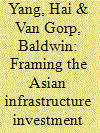|
|
|
Sort Order |
|
|
|
Items / Page
|
|
|
|
|
|
|
| Srl | Item |
| 1 |
ID:
165877


|
|
|
|
|
| Summary/Abstract |
This qualitative study is designed to identify the frames in the debate on the Asian Infrastructure Investment Bank (AIIB) and analyze the framing by different actors. To that end, it drew insights from framing theory and conducted an in-depth inductive frame analysis based on a representative sample of official documents and news articles. 14 frames (7 frames and 7 counterframes) emerged therefrom. They represent the AIIB debate along six dimensions: China vis-à-vis AIIB (Tool, We’re all equal), AIIB for members (Boon, Bane), AIIB versus status quo (Rival, Complement, Winds of change), standards (Made in China, Qualified yes, Up to par), prospects (Off to a good start, Not all roses), and external reactions (Game, Much ado about nothing). Building on the frames identified, the study went further to show how political actors applied frames in their (self-)justificatory discourse, and how media enriched the debate by bringing in frames absent from the official discussions in the political circle. The findings herein not only attest to the contested nature of the AIIB and the diverging framing by different actors, but shed some light on the wider discussions on China’s evolving relations with the incumbent global system and established powers.
|
|
|
|
|
|
|
|
|
|
|
|
|
|
|
|
| 2 |
ID:
169114


|
|
|
|
|
| Summary/Abstract |
This research examines throughout the rhetorical efforts of Chinese state media to externally legitimate the AIIB. To that end, it builds an analytical framework of legitimacy comprising four general dimensions—external, institutional, procedural and performance, each of which is substantiated by legitimacy claims specific to the AIIB. Empirically, the article is based on an in-depth content analysis of 730 AIIB-centric articles collected from four state media. The study finds the following: (1) Chinese state media grounded the AIIB’s justificatory rhetoric primarily on institutional legitimacy and external recognition, and more specifically, the bank’s utility, complementarity, and growing membership/support; (2) Chinese state media intensified rhetorical efforts following the UK’s announcement to join and increasing international attention on the new bank. The framework built and conclusions drawn herein can shed some light on China’s rhetorical legitimation of its emerging institution-building behavior.
|
|
|
|
|
|
|
|
|
|
|
|
|
|
|
|
| 3 |
ID:
160471


|
|
|
|
|
| Summary/Abstract |
In view of the resources invested by China in the Belt and Road Initiative (BRI) and the geopolitical-security dynamics at play, it is helpful to examine the notable security risks and uncertainties of the project. Embedded in this broad context, the paper at hand zooms in on one of the world’s most volatile regions—the Middle East, situated strategically at the juncture of the overland and seaborne routes. Substantively, it focuses on the security dynamics in the region and China’s current engagement therein, with a view to assessing whether and the extent to which China will boost its strategic presence in the BRI context. Some conclusions can be drawn from the research. First, the Middle East faces a multiplicity of security risks and challenges, compounded by a problematic existing security architecture based on inadequate cooperation among regional actors and questionable ad hoc interventions by major outside powers. Second, China’s current relations in Middle Eastern countries have been overwhelmingly economic and driven by energy. Its political-security presence, albeit growing, remains marginal. Third, given the imperatives for China to play a more substantial role in Middle Eastern security (not least the need to ensure the BRI’s security) and the risks/costs of doing so, it would make sense that China seeks to step up its game in areas that are conductive to stabilising the region and yet do not entail intensively investing strategic resources and publicly taking sides (e.g. infrastructure and conflict mediation). This offers reasonable prospect of further EU-China cooperation.
|
|
|
|
|
|
|
|
|
|
|
|
|
|
|
|
|
|
|
|
|